

The Amptek Silicon Drift Detectors (SDD) represent a breakthrough in x-ray detector technology by providing“off-the-shelf”performance previously available only from expensive cryogenically cooled systems.
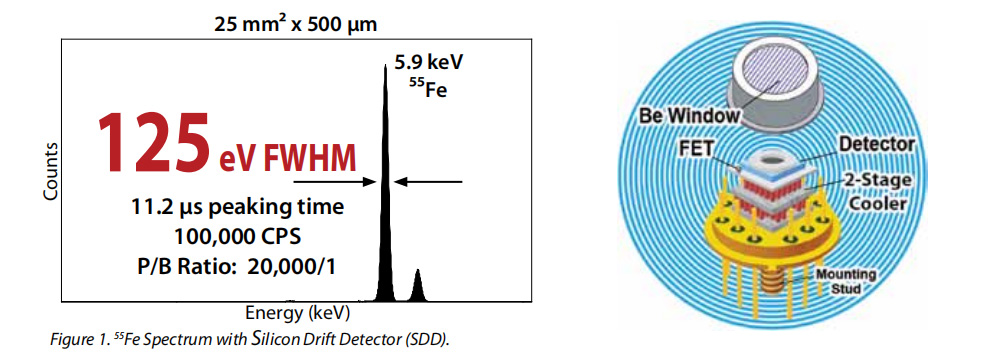
The XR-100SDD and X-123SDD Silicon Drift Detectors (SDD) are the latest additions to Amptek’s line of x-ray detectors that revolutionized the industry.
Their high performance, small size, and low cost make them the ideal detector for OEM hand-held applications to bench-top analyzers.
The SDD enables extremely high count rate applications with excellent energy resolution. The detector is housed inside the same TO-8 package as Amptek’s other detectors, so its form-factor is a direct replacement for current systems and is compatible with all Amptek accessories and options.
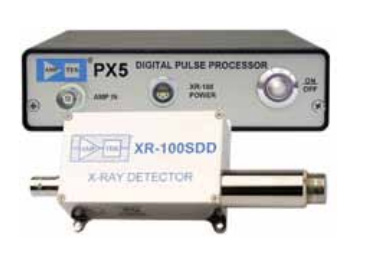
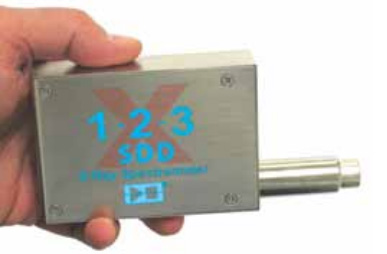
| General | |
| Detector Type | Silicon Drift Detector (SDD) |
| Detector Size | 25 mm2 |
| Silicon Thickness | 500 μm.See Figure 5 |
| Energy Resolution @ 5.9 keV (55Fe) | 125 - 140 eV FWHM at 11.2 μs peaking time |
| Peak to Background | 20000:1 (ratio of counts from 5.9 keV to 1 keV) |
| Background Counts | <3 x 10-3/s, 2 keV to 150 keV |
| Detector Be Window Thickness | 0.5 mil (12.5 μm).See Figure 5 |
| Collimator | Internal MultiLayer Collimator (ML) |
| Charge Sensitive Preamplifier | Amptek custom design with reset |
| Gain Stability | <20 ppm/°C (typical) |
| Case Size XR-100SDD X-123SDD | 3.00 x 1.75 x 1.13 in (7.6 x 4.4 x 2.9 cm) 3.94 x 2.67 x 1.0 in (10.0 x 6.78 x 2.54 cm) |
| Weight XR-100SDD X-123SDD | 4.4 ounces (125 g) 6.7 ounces (190 g) |
| Total Power XR-100SDD X-123SDD | <1 Watt 2.5 Watt (typical) |
| Warranty Period | 1 Year |
| Device Lifetime | Typical 5 to 10 years, depending on use |
| Storage &Shipping | Long-term Storage: 10+ years in dry environment Typical Storage & Shipping: -20°C to+50°C, 10 to 90% humidity noncondensing |
| Operation conditions | 0°C to +50°C |
| OEM | Compatible with all Amptek OEM configurations |
| XR-100SDD Inputs | |
| Preamp Power | ±8 to 9 V @ 15 mA with no more than 50 mV peak-to-peak noise |
| Detector Power XR-100SDD X-123SDD | -95 to -150 V @ 25 μA, very stable <0.1% variation -95 to -1500 V (typical -120 V) |
| Cooler Power Current Voltage | 350 mA maximum 3.5 V maximum with <100 mV peak-topeak noise |
| Note: The XR-100SDD includes its own temperature controller | |
| XR-100SDD Outputs | |
| Preamplifier Sensitivity Polarity Feedback | 1 mV/keV typical (may vary for different detectors) Positive signal output (1 k? max. load)Reset |
| Temperature Monitor Sensitivity | PX5/X-123: direct reading in Kelvin through software. |
| Note | |
| The SDD requires negative high voltage and produces a positive preamplifier output. This is the opposite of the standard Si-PIN which requires positive high voltage and produces a negative preamplifier output. When ordered in an XR100SDD/PX5 configuration, the PX5 is equipped with a negative high voltage supply. The new PX5 is also equipped with a positive high voltage supply.It can be used with all Amptek detector types, as well as, with many other radiation detectors and preamplifiers, including HPGe detectors and scintillators. | |
| Use of Collimators | |
| Most of Amptek’s detectors contain internal collimators to improve spectral quality. X-rays interacting near the edges of the active volume of the detector may produce small pulses due to partial charge collection. These pulses result in artifacts in the spectrum which, for some applications, obscure the signal of interest. The internal collimator restricts X-rays to the active volume, where clean signals are produced. Depending on the type of detector, collimators can improve peak to background (P/B); eliminate edge effects; and/or eliminate false peaks. For more information please see: http://www.amptek.com/ xrspectr.html#edge | |
| Vacuum Operation | |
| The XR-100SDD can be operated in air or in vacuum down to 10-8 Torr. There are two ways the XR-100SDD can be operated in vacuum: 1) The entire XR-100SDD detector and preamplifier box can be placed inside the chamber. In order to avoid overheating and dissipate the 1Watt of power needed to operate the XR-100SDD, good heat conduction to the chamber walls should be provided by using the four mounting holes. An optional Model 9DVF 9-Pin D vacuum feedthrough connector on a Conflat is available to connect the XR-100SDD to a PX5 outside the vacuum chamber. 2) The XR-100SDD or X-123SDD can be located outside the vacuum chamber to detect X-Rays inside the chamber through a standard Conflat compression O-ring port. Optional Model EXV9 (9 inch) vacuum detector extender is available for this application. Click here for more information on vacuum applications and options. For more information see: http://www.amptek.com/exv.html | |
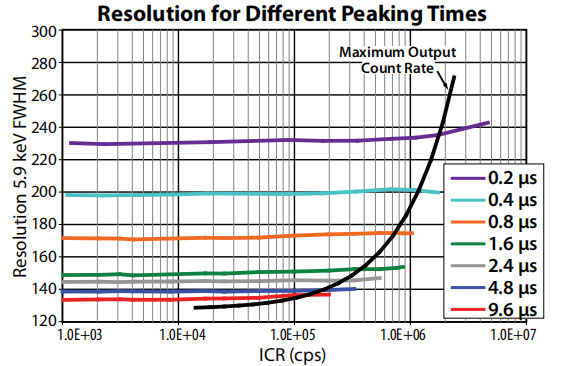 |  |
| Figure 2. Resolution vs. Input Count Rate for different peaking times for the SDD with the DP5. The plot also shows the curve of maximum output count rate. Operating to the right of that curve results in less throughput than the maximum despite a higher input rate. See Figure 3. | Figure 3. Throughput with the SDD. Due to the detector’s smaller capacitance, a much shorter peaking time is used in the shaping amplifier without sacrificing resolution. Typically 9.6 μs or less is used. This dramatically increases the throughput of the system. |
 | 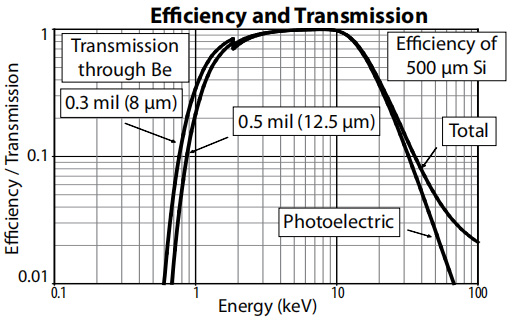 |
| Figure 4. Resolution vs. Peaking Time for the SDD. | Figure 5. The figure combines the effects of transmission through the Be window (including the protective coating), and interaction in the SDD. The low energy portion of the curve is dominated by the thickness of the Be window- either 0.3 mil (8 μm) or 0.5 mil (12.5 μm), while the high energy portion is dominated by the thickness of the active depth of the SDD - 500 μm. |
| | |
| | |
| |
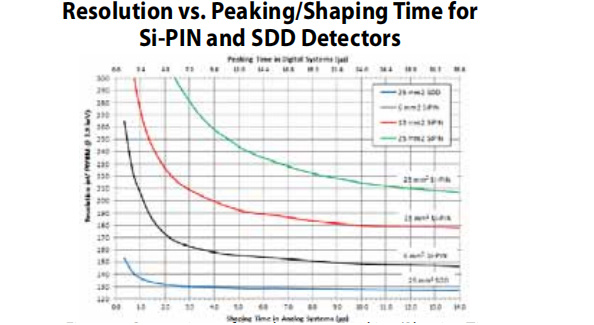 | 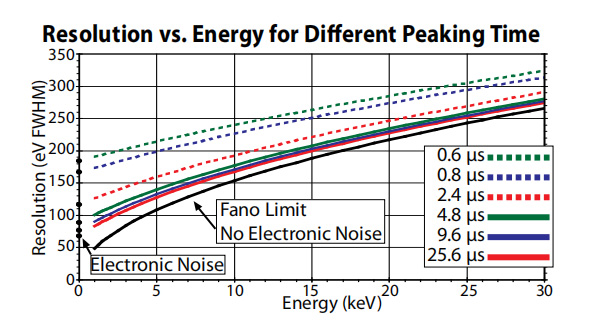 |
| Figure 6. Comparison of Resolution vs. Peaking/Shaping Timefor Si-PIN and SDD Detectors | Figure 7. Resolution vs. Energy for Different Peaking Times taken with the SDD. |
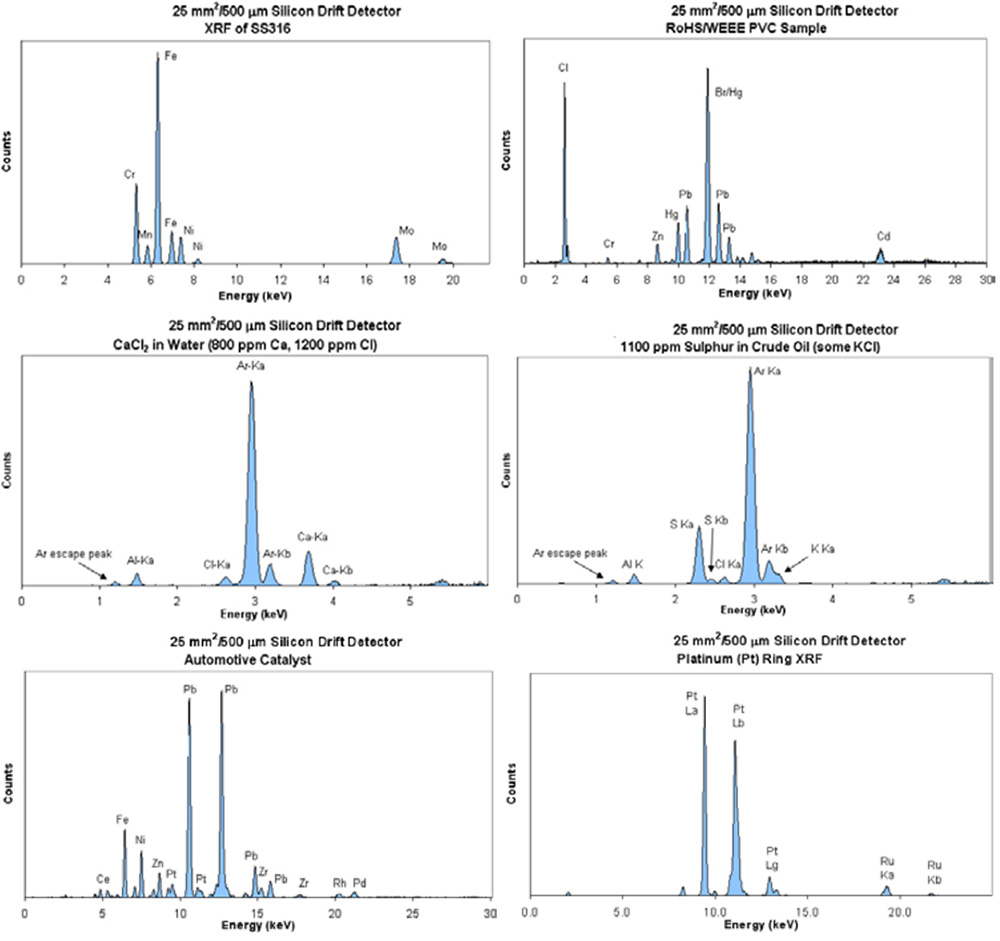
Experimenter’s XRF Kit with SDD 
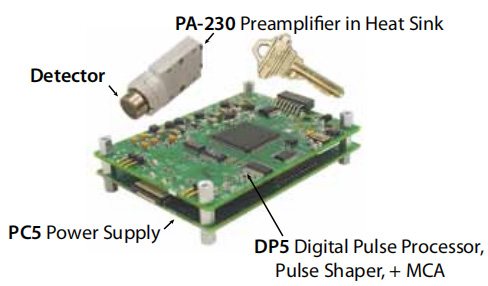
 微信二維碼
微信二維碼